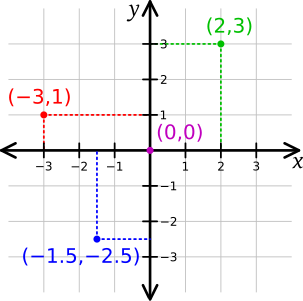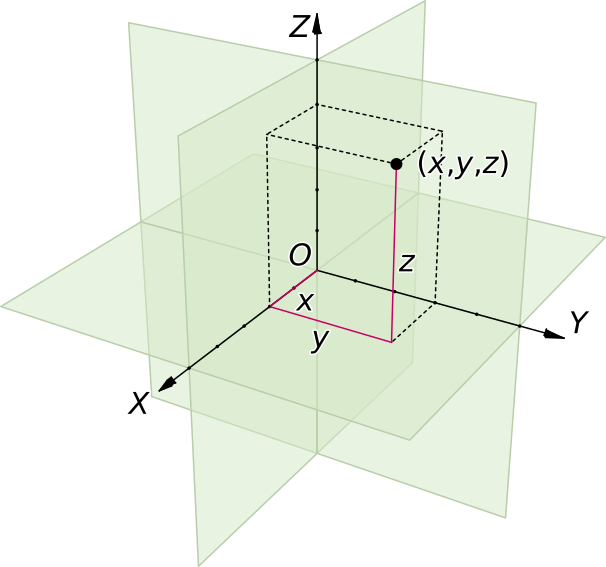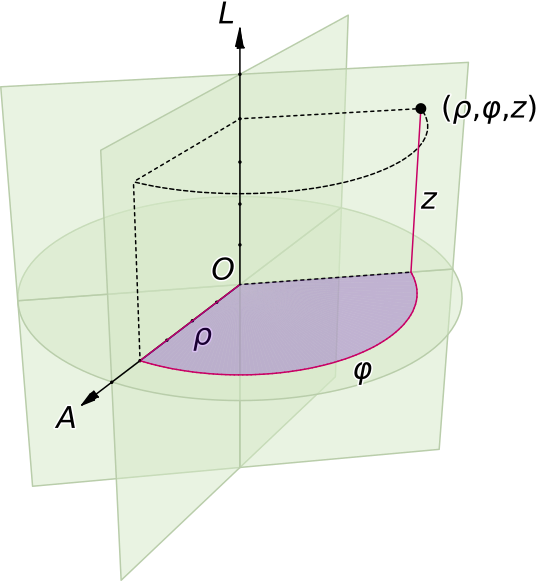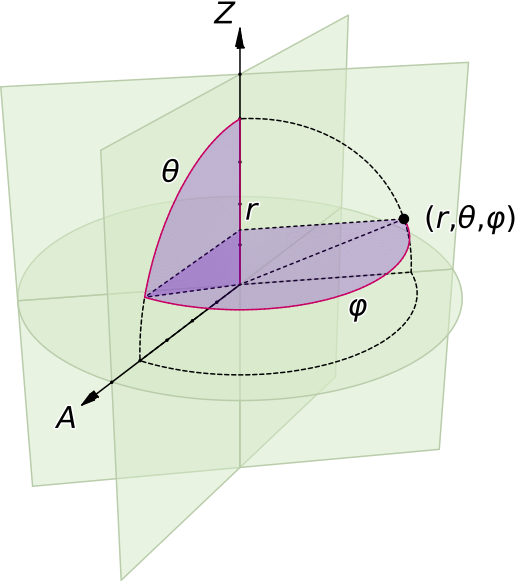5. Floating type structures¶
Array data are whatever data that can be contained in a multidimensional array (also called multidimensional matrix).
An HDF5 dataset is simply a multidimensional array, the values’s type of elements in a dataset is the same for all elements. This type can be :
Integer
Real
Double
String
Complex
Besides, in physics matrices’s dimensions are often linked to physical data. For instance, the first dimension of a temporal pulse current is the time. (The time being a one dimensional array (a vector) stored in a one dimensional HDF5 dataset)
To assure this association each matrix’s dimension must be linked to a dimension dataset :
data.h5/
|-- current # One dimensional real dataset parameterized by time
`-- time # One dimensional real dataset, current's abscissa
A second example is a current density on a surface at a given frequency, the current is a two dimensional matrix and the two dimensions are x and y that are the cartesian coordinates of a grid :
data.h5/
|-- current # Two dimensional real datasets parameterized by x and y
|-- x # First dimension : one dimensional real dataset
`-- y # Second dimension : One dimensional real dataset
Numeric structures of this kind (one dimensional datasets, multidimensional datasets, all manner to describing a list of numbers) are used in many cases and can be found out everywhere in an Amelet HDF file, they take the shape of HDF5 elements having an attribute named floatingType.
5.1. The floatingType category¶
In Amelet HDF floatingType are always children of another objects in
order to give it a meaning. However, it can happen a floatingType
instance is orphan, for instance the result of a simulation can be only a time,
a real number. The floatingType category contains orphan floatingType.
Example (see The SingleReal type for singleReal definition) :
data.h5/
|-- floatingType/
| `-- $flash_duration[@floatingType=singleReal
| @label=flash duration
| @physicalNature=time
| @unit=second
| @value=1e-9]
`-- simulation/
`-- $sim1[@module=my-module
| @version=1.2]
|-- inputs
`-- outputs
with data.h5:/simulation/$sim1/outputs :
/floatingType/$flash_duration |
5.2. Single types¶
Generally, Amelet HDF tries to use the simplest way to describe an element. For instance, a plane wave is defined by some attributes :
data.h5
`-- electromagneticSource
`-- planeWave
`-- $a-plane-wave[@xo=0.0
@yo=0.0
@zo=0.0
@theta=0.0
@phi=0.0
@linearPolarization=0.0]
$a-plane-wave’s’ attributes represents real numbers, their physical
nature and unit are set by Amelet HDF.
Sometimes, an attribute can be expressed by several ways. Take the electric conductivity of a material model, it could be defined with an HDF5 real attribute :
data.h5
`-- physicalModel/
`-- volume
`-- $water[@electricConductivity=10e-6]
However, the electric conductivity depends on the frequency, and the writing above is an approximation, the valid frequency interval is omitted.
For this case, Amelet HDF proposes a little more complex structure : the
single types singleReal and singleComplex.
The electric conductivity is evenly defined with a singleReal :
data.h5
`-- physicalModel/
`-- volume
`-- $water
`-- electricConductivity[@floatingType=singleReal]
@value=10e-6]
5.2.1. The SingleInteger type¶
A singleInteger is a floatingType that represents a integer
with optional attributes.
One mandatory attribute :
value: the value of the singleInteger, it is an HDF5 integer attribute.
Optional attributes :
label: the label of the singleIntegerphysicalNature: the physical nature of the singleIntegerunit: the unit of the singleIntegercomment: a comment
These attributes are all HDF5 string attributes.
data.h5
`-- floatingType/
`-- $an_integer[@floatingType=singleInteger
@value=7]
5.2.2. The SingleReal type¶
A singleReal is a floatingType that represents a real with optional
attributes.
One mandatory attribute :
value: the value of the singleReal, it is an HDF5 real attribute.
Optional attributes :
label: the label of the singleRealphysicalNature: the physical nature of the singleRealunit: the unit of the singleRealcomment: a comment
These attributes are all HDF5 string attributes.
It is usually used when an element can be defined by a single real number or an array. The electric conductivity definition of a material is a use case of the singleReal type :
data.h5
`-- physicalModel/
`-- volume
`-- $water
`-- electricConductivity[@floatingType=singleReal]
@value=10e-6]
5.2.3. The singleComplex type¶
A singleComplex is a floatingType that represents a complex number
with optional attributes :
One mandatory attribute :
value: a two elements array (real part, imaginary part) attribute, it is the value of the complex number.
Optional attributes :
label: the label of the singleComplexphysicalNature: the physical nature of the singleComplexunit: the unit of the singleComplexcomment: a comment
These attributes are all HDF5 string attributes.
It is usually used when an element can be defined by a single complex number or a complex array. The relative permittivity of a material is a use case of the singleComplex type :
data.h5
`-- physicalModel/
`-- volume
`-- $water
`-- relativePermittivity[@floatingType=singleComplex
@value=(80, 0)]
5.2.4. The singleString type¶
For the sake of completness,
a singleString is a floatingType that represents a string
with optional attributes :
One mandatory attribute :
value: a string attribute, it is the content of the string
Optional attributes :
label: the label of the singleComplexphysicalNature: the physical nature of the singleComplexunit: the unit of the singleComplexcomment: a comment
These attributes are all HDF5 string attributes.
As an example, the date unit can be expressed as a singleString
(see Dealing with date)
5.3. Vector¶
The next floatingType element we discuss is the vector.
A one dimensional dataset is a vector and can be explicitly defined or implicitly defined :
A vector is explicitly defined when all values are contained in the HDF5 dataset (A = [1, 2, 3, 4]),
floatingTypeequalsvectorin this caseA vector is implicitly defined when its values can be computed from parameters (A = [1, 10, 2], A is the set of 5 numbers starting at 1 to 10 using a 2 spacing)
Many formulations can be used to implicitly define a vector :
linearListOfReal1 : numberOfValues evenly spaced real numbers from first to last. linearListOfReal1’s parameters are :
first : the first value of the list
last : the last value of the list
numberOfValues : the number of values in the list
linearListOfReal2 : numberOfValues evenly spaced real numbers from first using “step” spacing. linearListOfReal2’s parameters are :
first : the first value of the list
step : spacing between values
numberOfValues : the number of values in the list
logarithmListOfReal : numberOfValues evenly spaced real numbers on a logarithmic scale. logarithmListOfReal’s parameters are :
first : the first value of the list
last : the last value of the list
numberOfValues : number of values
perDecadeListOfReal : numberOfValues evenly spaced real numbers on a logarithmic scale per decade. perDecadeListOfReal’s parameters are :
first : the first value of the list
numberOfDecades : the number of decades in the list
numberOfValuesPerDecade : the number of values per decades in the list
linearListOfInteger2 : numberOfValues evenly spaced integer numbers from first using “step” spacing. linearListOfInteger2’s parameters are :
first : the first value of the list
step : spacing between values
numberOfValues : the number of values in the list
Therefore, a one dimensional HDF5 dataset with the attribute floatingType
equals :
linearListOfReal1is a linearListOfReal1 list and have also the attributesfirst,lastandnumberOfValues. The dataset’s content is not taken into account.linearListOfReal2is a linearListOfReal2 list and have also the attributesfirst,stepandnumberOfValues. The dataset’s content is not taken into account.logarithmListOfRealis a logarithmListOfReal list and have also the attributesfirst,lastandnumberOfValues. The dataset’s content is not taken into account.perDecadeListOfRealis a perDecadeListOfReal list and have also the attributesfirst,numberOfDecadesandnumberOfValuesPerDecade. The dataset’s content is not taken into account.linearListOfInteger2is a linearListOfInteger2 list and have also the attributesfirst,lastandnumberOfValues. The dataset’s content is not taken into account.
For example with the preceding current density data :
data.h5/
|-- $current
|-- $x[@floatingType=vector]
|-- $y[@floatingType=linearListOfReal1,
| @first=1.0,
| @last=10.0,
| @numberOfValues=10]
`-- $z
$z is defined without attribute, when there is no attribute floatingType,
the element is a vector.
5.3.1. Interval¶
A real interval is classically defined by two real numbers (start, end) and
is written [start, end]. In
Amelet HDF, a real interval is described with a linearListOfReal1 with no
numberOfValues attribute.
Example :
data.h5/
`-- $int1[@floatingType=linearListOfReal1
@physicalNature=time
@first=0
@last=1e-6]
data.h5:/$int1 is a time interval starting from 0 second and terminating
at 1e-6 second.
5.4. Rational functions¶
5.4.1. Introduction¶
A rational function is any function which can be written as the ratio of two polynomial functions. (http://en.wikipedia.org/wiki/Rational_function).
5.4.2. The rational function¶
In Amelet HDF, rationalFunction is a floatingType, it can be found out
every where in an instance. A rationalFunction is the sum of fractions of
different types, the types are :
Type 1 : \(f(p) = B\)
Type 2 : \(f(p) = \dfrac{B}{p-A}\)
Type 3 : \(f(p) = \dfrac{B}{(p-A)^2}\)
Type 4 : \(f(p) = \dfrac{B}{(p-A)^2+(2\pi F)^2}\)
Type 5 : \(f(p) = \dfrac{B(p-A)}{(p-A)^2+(2\pi F)^2}\)
A rationalFunction is an named HDF5 table that has four columns :
type, A, B and F.
type is an HDF5 integer and the others are HDF5 reals.
Type 1 : only B is read
Types 2 and 3 : A and B are used
Types 4 and 5 : A, B and F are used
Example :
type |
A |
B |
F |
|---|---|---|---|
1 |
1 |
||
2 |
2 |
3 |
|
3 |
4 |
5 |
|
4 |
6 |
7 |
8 |
5 |
9 |
10 |
11 |
5.4.3. The general rational function¶
The general rational function is sometimes used to generalize the representation of frequency dependent properties of dielectric material for instance.
Two types of general rational function exist:
Polynomial
Partial fraction
A general rational function \(f(j\omega)\) of polynomial type is written as :
where \(a_i, b_i\) are complex numbers.
A general rational function \(f(j\omega)\) of partial fraction type is written as :
where \(a_i, b_i\) are complex numbers and \(k_i\) are integer numbers.
In Amelet HDF, generalRationalFunction is a floatingType, it can be found out
every where in an instance.
A floatingType generalRationalFunction has one more attribute:
type:typeis a HDF5 character attribute which gives the type of thefloatingType. It can take the valuespolynomialandpartialFraction.
5.4.3.1. General rational function of polynomial type¶
A generalRationalFunction of polynomial type is a 2 column dataset of
complex numbers ( {r, i} ).
The number of lines is the degree of the rational function, example :
degree |
numerator |
denominator |
|---|---|---|
0 |
(1, 2) |
(2, 4) |
1 |
(1, 1) |
(0, 2) |
2 |
(0, 2) |
(2, 0) |
. |
. |
. |
. |
. |
. |
. |
. |
. |
n |
(32, 2) |
(2, -12) |
The headers and the first column are represented for the explanation, the genuine dataset is :
(1, 2) |
(2, 4) |
(1, 1) |
(0, 2) |
(0, 2) |
(2, 0) |
. |
. |
. |
. |
. |
. |
(32, 2) |
(2, -12) |
This example defines a nth order general rational function and is equivalent to the following relation :
5.4.3.2. General rational function of partial fraction type¶
A generalRationalFunction of partial fraction type is an named HDF5
table that has three columns :
degree of the denominator, numerator and denominator.
degree is an HDF5 integer and the others are HDF5 complex numbers ( {r, i} ).
Example :
degree |
numerator |
denominator |
|---|---|---|
0 |
(5, 0) |
(1, 0) |
1 |
(3, 4) |
(1, 4) |
2 |
(2, 1) |
(1, 4) |
1 |
(0, 2) |
(2, 0) |
This example is equivalent to this rational fraction:
5.4.4. The rational¶
In order to be consistent with the floatingType dataSet relative to
singleReal and singleComplex, rationalFunction can be used
as element of a matrix named data. The element of data are HDF5 string,
names of the rationalFunction.
The resulting structure is a floatingType named rational,
it is a named HDF5 group and is made up of :
An HDF5 group named
functionthat containsrationalFunctionA
dataSetnameddataof HDF5 string
The floatingType rational is used for the definition of impedance :
(the whole definition of a /physicalModel/multiport will be seen later)
data.h5
/physicalModel/
`-- multiport/
`-- $impedance1[@floatingType=rational
| @physicalNature=impedance]
|-- function
| |-- $rationalFraction1[@floatingType=rationalFunction]
| |-- $rationalFraction2[@floatingType=rationalFunction]
| `-- $rationalFraction3[@floatingType=generalRationalFunction
| @type=polynomial]
`-- data
with /physicalModel/multiport/$impedance1/function/$rationalFraction1 :
type |
A |
B |
F |
|---|---|---|---|
1 |
1 |
||
2 |
2 |
3 |
|
3 |
4 |
5 |
|
4 |
6 |
7 |
8 |
5 |
9 |
10 |
11 |
and /physicalModel/multiport/$impedance1/function/$rationalFraction3 :
(1, 2) |
(2, 4) |
(1, 1) |
(0, 2) |
(0, 2) |
(2, 0) |
. |
. |
. |
. |
. |
. |
(32, 2) |
(2, -12) |
and /physicalModel/multiport/$impedance1/data :
$rationalFraction1 |
$rationalFraction3 |
$rationalFraction2 |
$rationalFraction1 |
5.4.5. Complex-conjugate pole-residue¶
A complex-conjugate pole-residue (CCPR) function \(f(j\omega)\) is written as :
where \(A, B, a_i, b_i\) are real numbers, \(c_i, d_i\) are complex numbers, \(z^*\) is the complex-conjugate of \(z\), \(N\) is the number of real poles and \(M\) is the number of complex-conjugate poles.
In Amelet HDF, complexConjugatePoleResidue is a floatingType, it can be found
out every where in an instance. It is a named HDF5 group with the attributes
constantgiving the value of \(A\)lineargiving the value of \(B\)
and two optional children
realPoleResidueis a 2 column dataset of real numbers containing \(b_i, a_i\).complexPoleResidueis a 2 column dataset of complex numbers containing \(d_i, c_i\).
Here is and example of a CCPR function.
data.h5
/floatingType/
`-- $CCPR[@floatingType=complexConjugatePoleResidue
| @constant=50
| @linear=1e-9]
|-- realPoleResidue
`-- complexPoleResidue
5.5. DataSet¶
The dataSet structure is another floatingType in the Amelet HDF
specification, it represents a matrix with physical quantity attributes.
A dataSet can be used to define a multiport resistance with
constant values for instance :
data.h5
`-- physicalModel/
`-- multiport/
`-- $resistance0[@floatingType=dataSet
@physicalNature=resistance
@unit=ohm]
In the example $resistance0 is a three ports multiport (given by the
dimension of HDF5 dataset),
/physicalModel/multiport/$resistance0 is :
12 |
13 |
14 |
13 |
12 |
13 |
14 |
13 |
12 |
HDF5 provides the API to query the dimension of the dataset.
Note
DataSet is a native HDF5 object.
5.6. ArraySet¶
An arraySet is another floatingType structure, it has an attribute
floatingType equals arraySet. The reason
of this floating characteristic is that an arraySet is a structure
that can be also used in many locations in a Amelet HDF instance.
An arraySet is defined by :
data, an HDF5 multidimensionnal dataset, its type can be :integer
real
double
complex
string
a “ds” group (dimension scale) that contains the HDF5 dataset representing data dimensions. If data’s dimension is 3, ds’s children are:
dim1, firstdata’s dimension.dim1is a one dimensional dataset.dim2, seconddata’s dimension.dim2is a one dimensional dataset.dim3, thirddata’s dimension.dim3is a one dimensional dataset.
The names
dim1…dimNis a Amelet HDF convention and are the only authorized names.
The first dimension is the most internal loop of data.
Example :
data.h5/
`-- floatingType/
`-- $eField[@floatingType=arraySet]
|-- data # a (n x m x l) dataset
`-- ds/
|-- dim1
|-- dim2
`-- dim3
In addition, Amelet HDF defines the manner to write scientific data the way there is no place for misunderstanding. That’s why the physical nature and unit of parameters are set by Amelet HDF to limit the complexity of the understanding and the treatment. There is no need the write code to convert the unknown input unit toward another unit.
However, arraySets can be read out of the context of Amelet HDF, simulation results can be stored in an arraySet file and there is no way to know the function, the nature and the unit of the data.
As a consequence the arraySet structure must be self-describing
and could provide optional attributes to precise the arraySet. The optional
attribute hold by data (as data is a floatingType=dataSet are :
the label ( HDF5 string attribute
label)the physical nature : “length”, “voltage” ( HDF5 string attribute
physicalNature)the unit : “meter”, “volt” ( HDF5 string attribute
unit)a comment ( HDF5 string attribute
comment)
In addition, the type (or the class) of the values (integer, float…) is
not published by an attribute, HDF5 provide the function
H5LTget_dataset_info, the returned type_class is the class of
the values.
5.6.1. The dimensions order¶
The “ds” group contains the HDF5 datasets representing data dimensions : the
ds/dim*.
They contain as well the physical nature of the dimensions, they follow the
rule :
ds/dim1is always the fastest-changing dimension.
5.6.2. C versus fortran - Storage conventions¶
C and fortran don’t use the same storage convention :
C : the last listed dimension is the fastest-changing dimension and the first-listed dimension is the slowest changing
Fortran : Fortran stores data by columns, the first-listed dimension is the fastest-changing dimension and the last-listed dimension is the slowest-changing
As a consequence, the array A(20, 100) allocated in C is the array A(100, 20) in fortran. HDF5 uses C storage conventions so an array stored from a C program must be read in the reversed order from a fortran program, the HDF5 wrapper accomplishes the task transparently for the user.
5.6.3. Component parameter¶
Numerical data can be scalar but can also be vector fields.
In this case, a dimension handle the component loop,
for this dimension the @physicalNature equals
component and values stored in the dataset are HDF5 string which are
the label of each component.
The possible components by coordinate system are :
Coordinate system |
Possible components |
|---|---|
Cartesian coordinate system |
x, y, z |
Cylindrical coordinate system |
r, theta, z |
Spherical coordinate system |
r, theta, phi |
5.6.3.1. Example 1¶
Example of the components Ex, Ey, Ez of an electric field during the time
data.h5/
`-- floatingType/
`-- $dataOne[@floatingType=arraySet
| @label=Electric field around a wire]
|-- data[@label=electric field
| @physicalNature=electricField
| @unit=voltPerMeter]
`-- ds/
|-- dim1[@label=component x y z
| @physicalNature=component]
`-- dim2[@label=the time
@physicalNature=time
@unit=second]
with data.h5:/floatingType/dataOne/ds/dim1 vector :
index |
component |
|---|---|
0 |
x |
1 |
y |
2 |
z |
5.6.3.2. Example 2¶
Example of the components Ex, Ey of an electric field during the time
data.h5/
`-- floatingType/
`-- $dataOne[@floatingType=arraySet
| @label=Electric field around a wire]
|-- data[@label=electric field
| @physicalNature=electricField
| @unit=voltPerMeter]
`-- ds/
|-- dim1[@label=component x y
| @physicalNature=component]
`-- dim2[@label=the time
@physicalNature=time
@unit=second]
with data.h5:/floatingType/dataOne/ds/dim1 vector :
index |
component |
|---|---|
0 |
x |
1 |
y |
5.6.4. Numerical data on mesh¶
Computations data are often located in space and a mesh
is used the associate a data value to a mesh entity.
In Amelet HDF this association is handled by a dim* child of the arraySet. The
physicalNature of this dimension must be meshEntity.
For a complete description of mesh see Mesh.
In this case, the dim* dataset is a string dataset and the values are the name of the mesh entity.
data.h5/
|-- mesh/
| `-- $gmesh1/
| `-- $mesh1/
| `-- group/
| `-- $exchange_surface[@entityType=node]
`-- floatingType
`-- $dataOne[@floatingType=arraySet
| @label=Electric field around the wire]
|-- data[@label=electric field
| @physicalNature=electricField
| @unit=voltPerMeter]
`-- ds/
|-- dim1[@label=component x y z
| @physicalNature=component]
|-- dim2[@label=mesh elements
| @physicalNature=meshEntity]
`-- dim3[@label=the time
@physicalNature=time
@unit=second]
with /floatingType/$dataOne/ds/dim2 :
/mesh/$gmesh1/$mesh1/group/$exchange_surface |
5.6.4.1. Numerical data on nodes¶
The preceding example deals with numerical data on nodes (the entityType is
node), that is to say all data are located on nodes in the node group.
Considering the meshEntity dimension, from the first value to last value,
values are located from the first node to the last node defined in the group
node.
5.6.4.2. Numerical data on unstructured elements - the location attribute¶
Data may also be located on the elements of a mesh. The following example
associates data on the barycenter of
/mesh/$gmesh1/mesh1/group/$exchange_surface elements :
data.h5/
|-- mesh/
| `-- $gmesh1/
| `-- $mesh1/
| `-- group/
| `-- $exchange_surface[@entityType=face]
`-- floatingType/
`-- $dataOne[@floatingType=arraySet
| @label=Electric field around the wire]
|-- data[@label=electric field
| @physicalNature=electricField
| @unit=voltPerMeter]
`-- ds/
|-- dim1[@label=component x y z
| @physicalNature=component]
|-- dim2[@label=mesh elements
| @physicalNature=meshEntity]
`-- dim3[@label=the time
@physicalNature=time
@unit=second]
with /floatingType/$dataOne/ds/dim2 :
/mesh/$gmesh1/mesh1/group/$exchange_surface |
The example deals with numerical data on elements (the entityType is
face), that is to say all data are located on elements in the group.
But how are data located within the element ? The answer is in the location
attribute.
When physicalNature is meshEntity, the dimension can have an optional
attribute named location. The location attribute is a string attribute
which can take the following values :
barycenter, data are located at the barycenter of the elements.node, data are located at element nodes.middleEdge, data are located at element middle edges ifentityType=faceorentityType=volumecenterFace, data are located at element center face ifentityType=volume.
If location is not present or not understood, its value is barycenter.
For this to be possible, implicit and explicit element definition are necessary :
Unstructured elements are explicitly defined by nodes. So element nodes are explicitly selectable.
In addition elementTypes details the definition of (implicit) subelements (edges for
entityType=face, edges and faces forentityType=volume) of an element, these subelements are numbered.Implicit subelements permit to select (n-1) dimensional subelements of an n dimensional element.
Important
A simple rule has to be followed to localize data on the mesh :
Data are distributed on points in the same order they are defined. If a point is already associated with a value, the process goes on with the next possible location.
5.6.4.2.1. Example 1¶
The first example deals with three reals located on triangles barycenter (one barycenter per element so three elements), the Amelet HDF structure looks like the following :
data.h5/
|-- mesh/
| `-- $gmesh1/
| `-- $mesh1[@type=unstructured]/
| |-- nodes
| |-- elementTypes
| |-- elementNodes
| `-- group/
| `-- $three_triangles[@type=element
| @entityType=face]
`-- floatingType/
`-- $dataOne[@floatingType=arraySet
| @label=Electric field on a triangle]
|-- data[@label=electric field
| @physicalNature=electricField
| @unit=voltPerMeter]
`-- ds/
`-- dim1[@label=mesh elements
@physicalNature=meshEntity
@location=barycenter]
data.h5:/mesh/$gmesh1/$mesh1/group/$three_triangles is :
14 |
23 |
5 |
data.h5:/floatingType/$dataOne/data is a one-dimensional real array,
its length is three and data.h5:/floatingType/$dataOne/ds/dim1 is :
/mesh/$gmesh1/mesh1/group/$three_triangle |
Associations between triangles and data are :
triangle 0 in ``$three_triangles`` (14) holds /floatingType/$dataOne/data[0]
triangle 1 in ``$three_triangles`` (23) holds /floatingType/$dataOne/data[1]
triangle 2 in ``$three_triangles`` (5) holds /floatingType/$dataOne/data[2]

Fig. 5.1 Data dispatching on a triangle (tri3)¶
5.6.4.2.2. Example 2¶
The second example deals with six reals located on two joint quad4 nodes, the Amelet HDF structure looks like the following :
data.h5/
|-- mesh/
| `-- $gmesh1/
| `-- $mesh1[@type=unstructured]/
| |-- nodes
| |-- elementTypes
| |-- elementNodes
| `-- group/
| `-- $two_quad4[@type=element
| @entityType=face]
`-- floatingType
`-- $dataOne[@floatingType=arraySet
| @label=Electric field on a quad4]
|-- data[@label=electric field
| @physicalNature=electricField
| @unit=voltPerMeter]
`-- ds/
`-- dim1[@label=mesh elements
@physicalNature=meshEntity
@location=node]
data.h5:/mesh/$gmesh1/$mesh1/group/$two_quad4 is :
12 |
27 |
data.h5:/mesh/$gmesh1/$mesh1/elementTypes is respectively for the 12th and
27th element :
… |
1 |
2 |
5 |
6 |
… |
2 |
3 |
4 |
5 |
… |
data.h5:/floatingType/$dataOne/data is a one-dimensional real array,
its length is six and data.h5:/floatingType/$dataOne/ds/dim1 is :
/mesh/$gmesh1/mesh1/group/$two_quad4 |
Associations between quad4 and data are :
quad4 0 in ``$two_quads4`` (12)
node 1 holds /floatingType/$dataOne/data[0]
node 2 holds /floatingType/$dataOne/data[1]
node 3 holds /floatingType/$dataOne/data[2]
node 4 holds /floatingType/$dataOne/data[3]
quad4 1 in ``$two_quads4`` (27)
node 2 holds /floatingType/$dataOne/data[4]
node 3 holds /floatingType/$dataOne/data[5]
Here, the first value in data is located on the first node of the first quad4, the second value on the second node, the third value on the third node of the first quad4, the fourth value on the fourth node. The other values are located on the second quad4 nodes. If the first node of the second quad4 is already associated with a value, we continue. Finally the last value is located on the only node (and last) that has no value of the second quad4.
Note
On the figure, external numbers are quad4 nodes indices defined in
data.h5:/mesh/$gmesh1/$mesh1/elementTypes and
data.h5:/mesh/$gmesh1/$mesh1/elementNodes and
internal numbers are nodes numbers relative to the element definition
see elementTypes)

Fig. 5.2 Data dispatching on quad4 nodes¶
This rule is valid for edges and faces.
5.6.4.3. Data and finite difference method - the location attribute¶
For finite difference (FD) methods under cartesian coordinate system, computed quantities are not all calculated at the same location :
Electric fields are located at cell’s middle edges
Magnetic fields are located at cell’s center faces
For instance, in a 2D Yee scheme Ex, Ey and Hx components are located as the following picture shows :

Fig. 5.3 Ex, Ey and Hx location in a 2d Yee grid¶
In addition structured entities (volumes, surfaces and edges) are defined by too end-corner points (see the gray zone on the picture) :
(imin, jmin, kmin) are the coordinates of the inferior end-corner point
(imax, jmax, kmax) are the coordinates of the superior end-corner point
The components contained in a such entity are (the fortran notation for integer range is used, Ex(1:2) is a two elements array with Ex(1) and Ex(2)):
Ex(imin:imax-1, jmin:jmax , kmin:kmax )
Ey(imin:imax , jmin:jmax-1, kmin:kmax )
Ez(imin:imax , jmin:jmax , kmin:kmax-1)
and
Hx(imin:imax , jmin:jmax-1, kmin:kmax-1)
Hy(imin:imax-1, jmin:jmax , kmin:kmax-1)
Hz(imin:imax-1, jmin:jmax-1, kmin:kmax )
To store Ex, Ey and Ez in a single arraySet and Hx, Hy and Hz in another
arraySet, a meshEntity dimension is defined by x, y, z and the shape
of the regular data dataset of the arraySet is
[imin:imax, jmin:jmax, kmin:kmax], as a consequence some components
are written but should not be consumed :
Ex(imax, jmin:jmax , kmin:kmax )
Ey(imin:imax , jmax, kmin:kmax )
Ez(imin:imax , jmin:jmax , kmax)
and
Hx(imin:imax , jmax, kmin:kmax-1) and Hx(imin:imax , jmin:jmax-1, kmax)
Hy(imax, jmin:jmax , kmin:kmax-1) and Hy(imin:imax-1, jmin:jmax , kmax)
Hz(imax, jmin:jmax-1, kmin:kmax ) and Hz(imin:imax-1, jmax, kmin:kmax )
The location attribute
In the case of finite difference methods, the
locationattribute isfiniteDifference
Note
Data are written in the same order the coordinate system dimension are defined. (x, y, z, or i, j, k for a cartesian coordinate system)
5.6.4.3.1. Example¶
For the the components from the image, the fields are stored as follows :
data.h5/
|-- mesh/
| `-- $gmesh1/
| `-- $mesh1[@type=structured]/
| |-- cartesianGrid/
| `-- group/
| `-- $gray_surface[@type=element
| @entityType=face]
`-- floatingType/
`-- $ex_and_ey[@floatingType=arraySet
| @label=Electric field on the gray surface]
|-- data[@label=electric field
| @physicalNature=electricField
| @unit=voltPerMeter]
`-- ds/
|-- dim1[@label=Ex and Ey
| @physicalNature=component]
`-- dim2[@label=the grey surface
@physicalNature=meshEntity
@location=finiteDifference]
with data.h5:/floatingType/$ex_and_ey/ds/dim1 :
index |
component |
|---|---|
0 |
x |
1 |
y |
and data.h5:/mesh/$gmesh1/$mesh1/group/$gray_surface is :
imin |
jmin |
k |
imax |
jmax |
k |
5.6.5. Examples of arraySets¶
The material relative permittivity definition (in
/physicalModel/volume):datais a one dimensional complex dataset without unit;ds/dim1is a one dimensional real dataset (a vector)physicalNature= “frequency”unit= “hertz”
A current pulse in the time domain
datais a one dimensional real datasetphysicalNature= “current”Unit= “ampere”
ds/dim1is a one dimensional real datasetphysicalNature= “time”unit= “second”
An electromagnetic pulse ExEy in the time domain :
datais a two dimensional real datasetphysicalNature= “electricField”unit attribute= “voltPerMeter”
ds/dim1is a one dimensional string datasetphysicalNature= “component”unit= “”values of
ds/dim1are [“x”, “y”]
ds/dim2is a one dimensional real datasetphysicalNature= “time”unit= “second”
The definition of a resistance found out in the
/physicalModel/resistancecategory :datais a one dimensional real datasetphysicalNature= “resistance”unit= “ohm”
ds/dim1is a one dimensional real datasetPhysicalNature= “frequency”Unit= “hertz”
5.6.6. The complement group¶
An arraySet can have an optional complement group. If present, this group
contains floatingType elements aiming at completing the meaning
of the arraySet.
Example :
data.h5/
`-- floatingType/
`-- $dataOne[@floatingType=arraySet
| @label=Current on the wire]
|-- complement/
| `-- temperature[@floatingType=singleReal
| @label=temperature
| @physicalNature=temperature
| @unit=kelvin
| @value=215]
|-- data[@label=current
| @physicalNature=current
| @unit=ampere]
`-- ds/
|-- dim1[@label=height
| @physicalNature=length
| @unit=meter]
|-- dim2
|-- dim3
`-- dim4
In this example, data.h5:/floatingType/$dataOne is completed by the
singleReal temperature.
5.6.7. ArraySet and Coordinate systems¶
For simple use cases, Amelet HDF defines conventions to express data in coordinate systems instead of creating a mesh and locating data on this mesh’s entities with the (component, entity) paradigm.
Note
Images of this section come from Wikipedia (http://www.wikipedia.org)
The convention is based upon the coordinateSystem attribute, it can take
the following values :
xxyxyzrthetarhophizrthetaphi
Those values are explained hereafter.
5.6.7.1. Cartesian coordinate system¶
Given the definition of the cartesian coodinate systems in 2 and 3 dimensions :

Fig. 5.4 A 2D cartesian coordinate system¶

Fig. 5.5 A 3D cartesian coordinate system¶
If an arraySet has the
coordinateSystemattribute equals tox, the arraySet must have a dimension with@labelequalsx. This dimension represents the X axis of a one-dimensional cartesian coordinate system.If an arraySet has the
coordinateSystemattribute equals toxy, the arraySet must have two consecutive dimensions with@labelequalsxand@labelequalsy. These dimensions represent the X axis and the Y axis of a two-dimensional cartesian coordinate system.If an arraySet has the
coordinateSystemattribute equals toxyz, the arraySet must have three consecutive dimensions with@labelequalsx,@labelequalsyand@labelequalsz. These dimensions represent the X axis, the Y axis and the Z axis of a three-dimensional cartesian coordinate system.
Example with a three-dimensional coordinate system :
data.h5/
`-- floatingType/
`-- $e_field[@floatingType=arraySet
| @coordinateSystem=xyz
| @label=electric field magniture in a box]
|-- data[@label=electric field magniture
| @physicalNature=electricField
| @unit=voltPerMeter]
`-- ds/
|-- dim1[@label=x
| @physicalNature=length
| @unit=meter]
|-- dim2[@label=y
| @physicalNature=length
| @unit=meter]
`-- dim3[@label=z
@physicalNature=length
@unit=meter]
5.6.7.2. Cylindrical and polar coordinate systems¶
Given the definition of the polar coordinate system :

Fig. 5.6 A polar coordinate system¶
If an arraySet has the coordinateSystem attribute
equals to rtheta, the arraySet
must have two consecutive dimensions with @label equals r and
@label equals theta. These dimensions represent
the r parameter and the theta parameter of the polar coordinate system.
Example :
data.h5/
`-- floatingType/
`-- $e_field[@floatingType=arraySet
| @coordinateSystem=rtheta
| @label=electric field magniture in a circle]
|-- data[@label=electric field magniture
| @physicalNature=electricField
| @unit=voltPerMeter]
`-- ds/
|-- dim1[@label=r
| @physicalNature=length
| @unit=meter]
`-- dim2[@label=theta
@physicalNature=angle
@unit=degree]
Given the definition of the cylindrical coordinate system :

Fig. 5.7 A cylindrical coordinate system¶
If an arraySet has the coordinateSystem attribute
equals to rhophiz, the arraySet
must have three consecutive dimensions with @label equals rho,
@label equals phi and @label equals z. These dimensions
represent the rho parameter, the phi parameter and the z parameter
of the cylindrical coordinate system.
Example :
data.h5/
`-- floatingType/
`-- $e_field[@floatingType=arraySet
| @coordinateSystem=rhophiz
| @label=electric field magniture in a cylinder]
|-- data[@label=electric field magniture
| @physicalNature=electricField
| @unit=voltPerMeter]
`-- ds/
|-- dim1[@label=rho
| @physicalNature=angle
| @unit=degree]
|-- dim2[@label=phi
| @physicalNature=angle
| @unit=degree]
`-- dim3[@label=z
@physicalNature=length
@unit=meter]
5.6.7.3. Spherical coordinate system¶
Given the definition of the spherical coordinate system :

Fig. 5.8 A spherical coordinate system¶
If an arraySet has the coordinateSystem attribute equals to rthetaphi,
the arraySet
must have three consecutive dimensions with @label equals r,
@label equals theta and @label equals phi. These dimensions
represent the r parameter, the theta parameter and the phi
parameter of the spherical coordinate system.
Example :
data.h5/
`-- floatingType/
`-- $e_field[@floatingType=arraySet
| @coordinateSystem=rthetaphi
| @label=electric field magniture in a sphere]
|-- data[@label=electric field magniture
| @physicalNature=electricField
| @unit=voltPerMeter]
`-- ds/
|-- dim1[@label=r
| @physicalNature=length
| @unit=meter]
|-- dim2[@label=theta
| @physicalNature=angle
| @unit=degree]
`-- dim3[@label=phi
@physicalNature=angle
@unit=degree]
5.6.8. ArraySet for radiation caracteristics of antenna¶
For radiation caracteristics of antenna (far-field, radiation pattern,
gain, efficiency), which are computed or measured relative to the direction,
Amelet-HDF uses the rthetaphi coordinate system but
by omitting the r dimension:
Example :
data.h5/
`-- floatingType/
`-- $gain[@floatingType=arraySet
| @coordinateSystem=rthetaphi
| @label=gain of an electric dipole]
|-- data[@label=gain
| @physicalNature=gain]
`-- ds/
|-- dim1[@label=frequency
| @physicalNature=frequency
| @unit=hertz]
|-- dim2[@label=theta
| @physicalNature=angle
| @unit=degree]
`-- dim3[@label=phi
@physicalNature=angle
@unit=degree]
5.7. Expression¶
5.7.1. Overview¶
Expression is a floatingType structure which defines data by
a mathematical expression thanks to embedded floatingTypes.
A floatingType expression is an HDF5 group with a mandatory HDF5 string
attribute named expression, it gives the value of the expression.
As usual, common floatingType attributes (label, comment,
physicalNature and unit) are optional.
Example :
data.h5
|
`-- floatingType/
`-- $U[@floatingType=expression
| @expression=$R*$I
| @physicalNature=voltage
| @unit=volt]
|-- $R[@floatingType=dataSet
| @physicalNature=impedance
| @unit=ohm]
`-- $I[@floatingType=dataSet
@physicalNature=current
@unit=ampere]
In the example $U is defined by the multiplication of $R and $I.
5.7.2. Simple cases¶
In the case of common binary operators +, -, *, /, Amelet HDF defines
the following shortcut :
The expression is reduced to the operator sign
Operands are named
operand1andoperand2
Example : the preceding floatingType data.h5:/floatingType/$U can be
re-written as :
data.h5
|
`-- floatingType/
`-- $U[@floatingType=expression
| @expression=*
| @physicalNature=voltage
| @unit=volt]
|-- operand1[@floatingType=dataSet
| @physicalNature=impedance
| @unit=ohm]
`-- operand2[@floatingType=dataSet
@physicalNature=current
@unit=ampere]
